The final sequence of Antonioni’s Il grido. Began as documentarist in this region, interested in landscape earlier features were melodramas, here returns to Po valley, last film before famous trilogy: L’avventura, L’eclisse, La notte(1960-63). Antonioni’s first color film, Red Desert (1964) sealed his reputation as a high modernist, a reexamination of same topics as Il grido, but greater shift from neorealist observation to modernist reflexivity. Story of film: Aldo, industrial worker and his growing alienation from other people (workers, lovers), final realization of the physical and spiritual emptiness that surrounds him. This sequence contrasts social agitation of factory workers struggling with police against the lonely journey of one worker, followed by Elvira, one of his mistresses…
|
IMAGE
|
SHOT DESCRIPTION
|
ANALYSIS
|
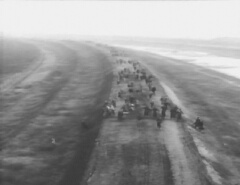 |
Editing: shot#1 Cinematography: ELS, extreme high angle establishing shot. grey tone: low contrast black and white images. Sound: people running and shouting Mise-en-scene: Misty landscape – never get clear shot in film. |
Aerial view. Familiar from landscape documentaries. People lost in / vanishing into the landscape. Problem of individual consciousness reaches climax in this film. Po valley, famous neorealist location, from end of Paisa (1946). |
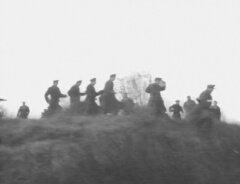 |
Editing: shot#2, match in action of the protesters going off the road Cinematography: LS, camera descends to eye level Sound: sounds gets louder, as demonstrators clash with the police Mise-en-scene: silhouettes against the sky; even if far away, the caps allows to tell policemen apart |
Police and protestors as two vectors across the landscape. Depersonalized forces. |
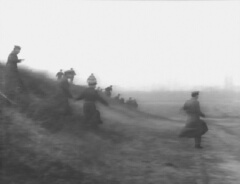 |
Editing: same shot Cinematography: LS, tracks down the steep, following the people as they get off the road Sound: shouting keeps getting louder Mise-en-scene: same as above |
Graceful camera movement that mimics the terrain. |
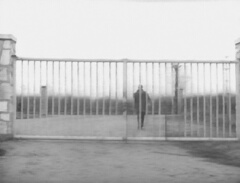 |
Editing: shot#3, quick cut Cinematography: ELS, pans left following Aldo as he enters the factory through the side door Sound: sudden change to total silence; we only hear Aldo’s footsteps Mise-en-scene: Aldo approaches and grasps prison-like fence; individual vs. modern/industrial building constrasted with groups/ nature of previous scenes |
Contrast w/ Aldo – single figure, returning to the deserted factory LS; The bars on the grate are like a prison. Aldo wants to get away from the world. Washed out images in this sequence: low contrast black and white as corrolary to vitiated emotions. time of day usually unspecific in this film. Season is late autumn/winter. |
 |
Editing: same shot (long take). Cinematography: LS, pan continues and tracks forwards (or zooms?) onto Aldo, turns into a MLS Sound: Aldo’s footsteps, which grow louder or softer as he stops or quicken his pace Mise-en-scene: stresses Aldo’s isolation, deserted factory. Shift from landscape to factory. |
Dead time: actions not simply achieved but constantly obstructed, derailed. Challenging for the viewer too… |
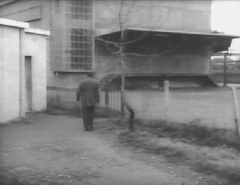 |
Editing: same shot Cinematography: camera stops panning at the fence and follows Aldo as he goes further inside, goes from MLS to LS to ELS Sound: Mise-en-scene: bare tree, deserted sugar refinery, grey buildings against grey sky. |
Lack of contrast in the image reduces the distinction between landscape and factory. Landscape drab, so is factory, so are people. One of Antonioni’s main themes is the denaturalization of the landscape. |
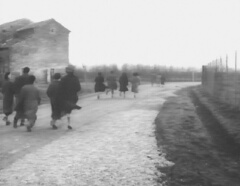 |
Editing: shot#4, abrupt cut, back to the demonstration. Cinematography: LS, camera pans slightly right, taking the curve and following a woman who steps out Sound: again, abrupt change in dynamics, loud, fast footsteps of many people running Mise-en-scene: woman singled out by her running across the screen |
Looks like she’s part of running group, but separated in image. we realize that she is Elvira, whom we have seen in the previous sequence running after Aldo. |
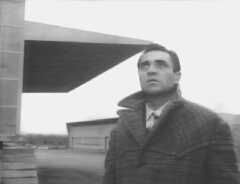 |
Editing: shot#5, another quick cut, by now we know this is parallel editing; an eyeline match to something above is suggested as Aldo lifts up his eyes, but we can’t see what he is looking at (tower, already important in the diegesis). Cinematography: MS Sound: again, change to total silence Mise-en-scene: Aldo looks up at tower. |
Tower is significant in this film: this is where Aldo worked. Film refuses to show us Aldo’s perspective, or even his eyeline match to the tower that we realize he is looking at. Like the relations between the characters, all linkages in this film are tenuous. |
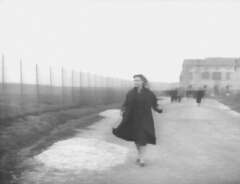 |
Editing: shot#6, cut back to the road Cinematography: LS of a woman (Elvira?); track/pan as she separates herself from the protesters and runs toward the factory fence Sound: now her sound is matched to Aldo’s, softer, only one set of footsteps Mise-en-scene: Elvira separated from the group, moving toward factory. |
Parallel construction of the editing between Aldo and the woman who is chasing him is emphasized by contrast of loud/quiet sound of feet. |
 |
Editing: same shot Cinematography: MLS of Elvira (always tracks along with her) as she presses herself againts the fence Sound: silence Mise-en-scene: deep space, we realize this is Aldo in the background |
The fence and the dark shape of the earth bank correlate with the emotional separation between these characters, part of the emotional background that leads to the conclusion of the film. |
 |
Editing: shot#7, match in action/eyeline match, as Elvira was looking at Aldo walking away Cinematography: MS. tracking Aldo, as he stops and starts Sound: Aldo’s footsteps, slowing, as if in doubt Mise-en-scene: Framing constantly changes, Aldo framed against buildings for most of this sequence. |
Again, notice that time slows down with Aldo; he is the only one not running, and he is shot in longer takes with minimal sound. This is not the cause-and-effect chain of plot but the dead time of story. He just wanders around, looking at the deserted buildings. |
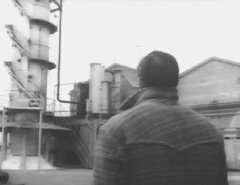 |
Editing: same shot (long take) Cinematography: MLS, camera stops tracking as Aldo stops to look a the tower. Sound: silence, then louder footsteps as Aldo makes up his mind and goes towards the tower Mise-en-scene: Now Aldo ventures into central compound, we see refinery tower where he worked in the background. |
The tower. This was the place where Aldo is first shown in the film, before descending and running out through the gate. The recapitulation of that scene in reverse suggests that the story is coming full circle. |
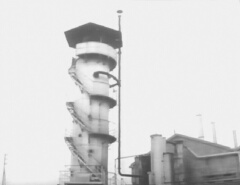 |
Editing: same shot Cinematography: LS, tilt that brings the top of the tower on screen and leaves Aldo off screen. Sound: footsteps Mise-en-scene: Tower dominates the composition. Another solitary composition in the film. |
We realize the tower, like Aldo, is a marker of solitude. Aldo is associated with the tower as elements that physically stand apart from their surroundings. |
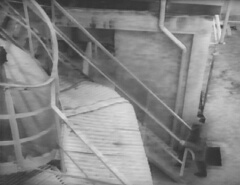 |
Editing: shot#8 cut, real time: cut to HA shots Cinematography: LS, high angle, crane (tracks upwards)as Aldo goes up the stairs Sound: silence, Aldo slow but firm steps Mise-en-scene: rails and metal surfaces of the tower. |
Real time / dead time. The time Aldo is absent from the previous shot seems approximately equal to the time it would take for Aldo to reach the tower — the film insists of the real time of action, at the expense of drama. |
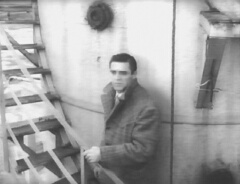 |
Editing: same shot (long take, we get to see each step on the stairs) Cinematography: MS, as Aldo gets neare to the camera, which keeps craning (not a tilt) and reframing on him. Sound: steps Mise-en-scene: Aldo looking out, no idea what he’s looking at. |
Film narration is uncommunicative in not letting us know what characters see or even what they are about to do: we have to reconstruct their field of view in retrospect and are constantly surprised by what they do. |
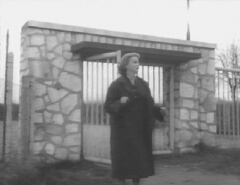 |
Editing: shot#9, cut as Aldo leaves frame in previous shot Cinematography: mirrors Aldo entrance (reinforces parallel construction), from ELS to MS as Elvira approaches the camera Sound: hurried footsteps Mise-en-scene: recognize factory landmarks |
Same scale as Aldo before, LS, then she gets nearer, etc. but she is running, and we don’t see her whole movements (much shorter takes) each character has a different time signature. The film establishes different rhythms for different characters. This is a more important structureal principle than the typical narrative arc. |
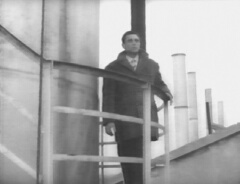 |
Editing: shot#10, cut Cinematography: MLS, camera pans/tilts, keeps following Aldo’s ascent Sound: light footsteps Mise-en-scene: continues following Aldo’s actions from shot #8 |
Before, we had an opposition between the longer shots of Aldo and shorter shots of Elvira following. Now the length of the shots becomes similar, but the pace within the shot is still contrasted: Elvira always runs, while Aldo moves slowly. |
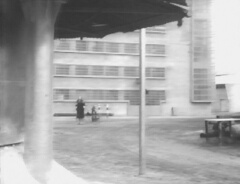 |
Editing: shot#11, cut Cinematography: ELS Sound: silence (footsteps in the distance) Mise-en-scene: again, Elvira retraces Aldo’s path |
Elvira’s urgency is contrasted to Aldo’s previous pensive mood. She does not care for the buildings, does not belong there, as Aldo does. The longer takes emphasize Aldo’s connection with the factory, which is not so significant to Elvira. Accordingly, Elvira’s scenes in the factory are significantly shorter than Aldo’s. |
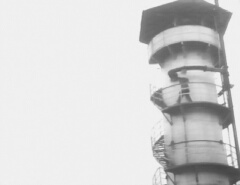 |
Editing: shot#12, eyeline match, as shot#11 end with Elvira looking up Cinematography: ELS; unbalanced framing Sound: silence (footsteps in the distance) Mise-en-scene: striking modernist composition, de-centered, as Aldo and the tower become one. |
Aldo goes further and further away from the world, becomes more and more insignificant.He has been associated with the tower from the beginning of the film and now he returns to it. The movement hints at a spiritual aspect of the film: Aldo is portrayed as a kind of “holy fool” who hasn’t adapted to the modern world. |
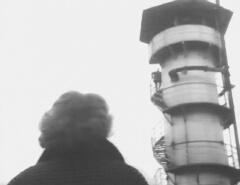 |
Editing: same shot Cinematography: MS of Elvira as she comes into the foreground, ELS of Aldo. Sound: loud and near as Elvira steps in Mise-en-scene: use of offscreen space; as soon as Elvira comes in, she balances the frame |
The composition of this shot reinforces the paired relation between Aldo and Elvira, in their simultaneous similarity and opposition. They are present to each other but out of reach. False POV shot: seems like the tower is seen from Elvira’s perspective, as shown in shot#11, but then she walks into the frame. This ambiguous setup is common to Antonioni: the arrangement of camera, subject, and object is understood retrospectively, in contrast to the piecemeal style that leads a viewer through the significant elements of a scene. |
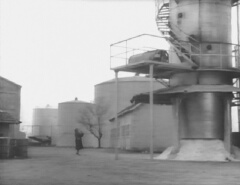 |
Editing: same shot (long take) Cinematography: ELS as Elvira runs towards the side of the tower, slight tilt downwards to follow her Sound: hurried, sudden footsteps running away; first word of the sequence, as she shouts his name. Mise-en-scene: Elvira is again dwarfed by the tower |
Contrast between puny human figure and the monumental tower and buildings; sense of hopelessness of her cause is nowhere more evident, as her cry pierces the empty space. The tower looks increasingly “alien” — less an industrial machine than a space ship. |
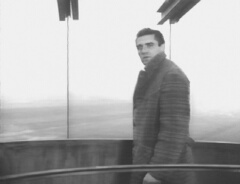 |
Editing: shot#13, cut. Reaction shot as Aldo starts, hearing Elvira’s call. Cinematography: MLS Sound: Elvira’s voice, Aldo’s footsteps Mise-en-scene: gesturing; Aldo looks baffled, as if awakening from a trance |
Notice that Aldo is more and more often shot from the back, stressing his alienation/indifference to everything around him. This is the last time we will clearly see his face; almost as if he is taking his leave. The last frame after he exits is empty, again reinforcing the feeling that “he is no longer there”. Contrast of shot scale between the end of shot 12 and the beginning of shot 13 marks an emphatic break. The sequence is accelerating to its conclusion. |
 |
Editing: shot#14, match in action as Aldo enters the frame Cinematography: MS of Aldo, ELS of Elvira, high angle. Unusual, high angle over-the-shoulder shot. Sound: Elvira’s voice Mise-en-scene: deep space, deep focus, contrast in size of figures |
Contrast of size underlines sense that Aldo is removed from emotional contact with his ex-mistress. Also from the human scale of objects on the ground. |
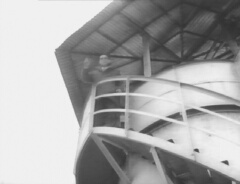 |
Editing: shot#15, match in action as Aldo waves his hand; and a suggested POV shot from Elvira’s perspective. Cinematography: LS, low angle. Space seems flattened: Perhaps a telephoto lens? Sound: silence Mise-en-scene: Staircase traps Aldo. |
Aldo is now definitevely trapped in a narrow space, after traveling across so many open, empty spaces. End of the road, with nowhere to go. Again, POV is understood only retrospectively, when we see the following shot of Elvira. |
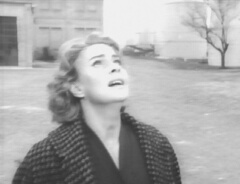 |
Editing: shot#16, eyeline match on object of Aldo’s gaze Cinematography: MCU Sound: she utters a cry, as she notices Aldo’s swaying, then anguished silence Mise-en-scene: wintry, industrial scene. Inexpensive, nondescript clothing — Elvira is a housewife. |
First close-up of Elvira, thus allowing her some individuality/ feelings. Meshing of nature and factory into modern, inhuman space. Tree in the background as unexpected intrusion of nature into factory compound. Will recur later. |
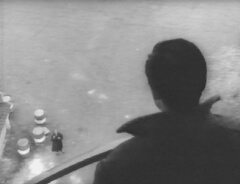 |
Editing: shot#17, shot/reverse shot with shot#18, same as shot#14 and shot#15 Cinematography: MS of Aldo, ELS of Elvira, high angle Sound: total silence Mise-en-scene: deep space, deep focus, contrast in size of figures, same camera placement as shot#14 |
Scene is extended in duration but sense of dead time replaced by sense of anxiety. What will happen? Repeated shot reinforces sense of trance-like repetition in this scene that is a culmination of Aldo’s almost somnambulist procession around the countryside in this film. |
 |
Editing:shot#18, shot/reverse-shot, graphically matched to shot 12 but from another position Cinematography: MLS of Elvira, ELS of Aldo, low angle Sound: total silence Mise-en-scene: deep space, deep focus: we see Aldo start to fall |
Tension between graphic pattern and spatial dislocation. Elvira has been running through the whole sequence but not she stands and watches. |
 |
Editing: shot#19, cut. reaction shot of Elvira as she looks at Aldo Cinematography: MS Sound: sudden, desperate cry of Elvira (“il grido”) as Aldo falls; we hear him crashing to the ground offscreen Mise-en-scene: Violent gestures of surprise and anguish |
Shot scale: this is the first MS of Elvira in the sequence. She screams: this is “Il grido” (the scream) of the title, a (possible) connection to Munch’s painting of the same name and same theme (modern alienation). Melodrama reappears when she screams/gestures but is at the same time attenuated by the dubbing (sound comes from somewhere else and it shows) and thematically as well since this is not the “important” woman; more a casual witness, really. Plus, we don’t see Aldo falling, only a thud as he crashes. Desperate gestures, which seem all the more brutal when contrasted with the emotional monotony of the film. |
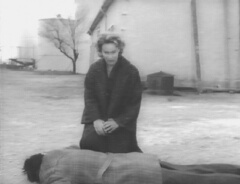 |
Editing: same shot Cinematography: slow crane movement sideways and to lower level, from MS to LS. Same angle. Sound: silence; at the end of the scene soundtrack music starts playing, for the first time in the sequence Mise-en-scene: Elvira walks up to and kneels besides Aldo’s body. Prostrate body, kneeling body, tree in background. Deep space, frontal blocking |
Quasi-religious associations with Pieta; she is the more motherly of all three women (2 children, and Aldo). Never see his face in the final moments, either too far away, or shot from the back. Further non-identification (opposite of melodrama) She kneels beside him, silent. Soundtrack music starts, first time in the whole sequence, sounds odd, almost vulgar. A waltz (played with some electronic instruments, sounds a bit mechanical). Incongruous conclusion to the film. |
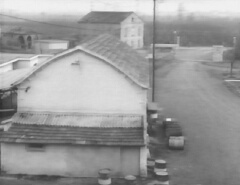 |
Editing: shot#20, cut Cinematography: ELS of the empty factory, high angle Sound: soundtrack music Mise-en-scene: deserted factory, deep space, we still see people & horses on the road, in the background |
Very unexpected ending, further modernist detachment, but also reserved in its refusal to show gruesome spectacle. The film reworks vulgar melodramatic intimacy in its respect for the suffering of the characters and their fundamental impenetrability. People passing onthe road in the background remind us that life goes on, indifferent to individual suffering. |
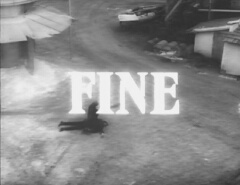 |
Editing: same shot. Cinematography: camera pans and tilts down to include the two figures, ELS, high angle. The End appears Sound: soundtrack music Mise-en-scene: |
Fine |
